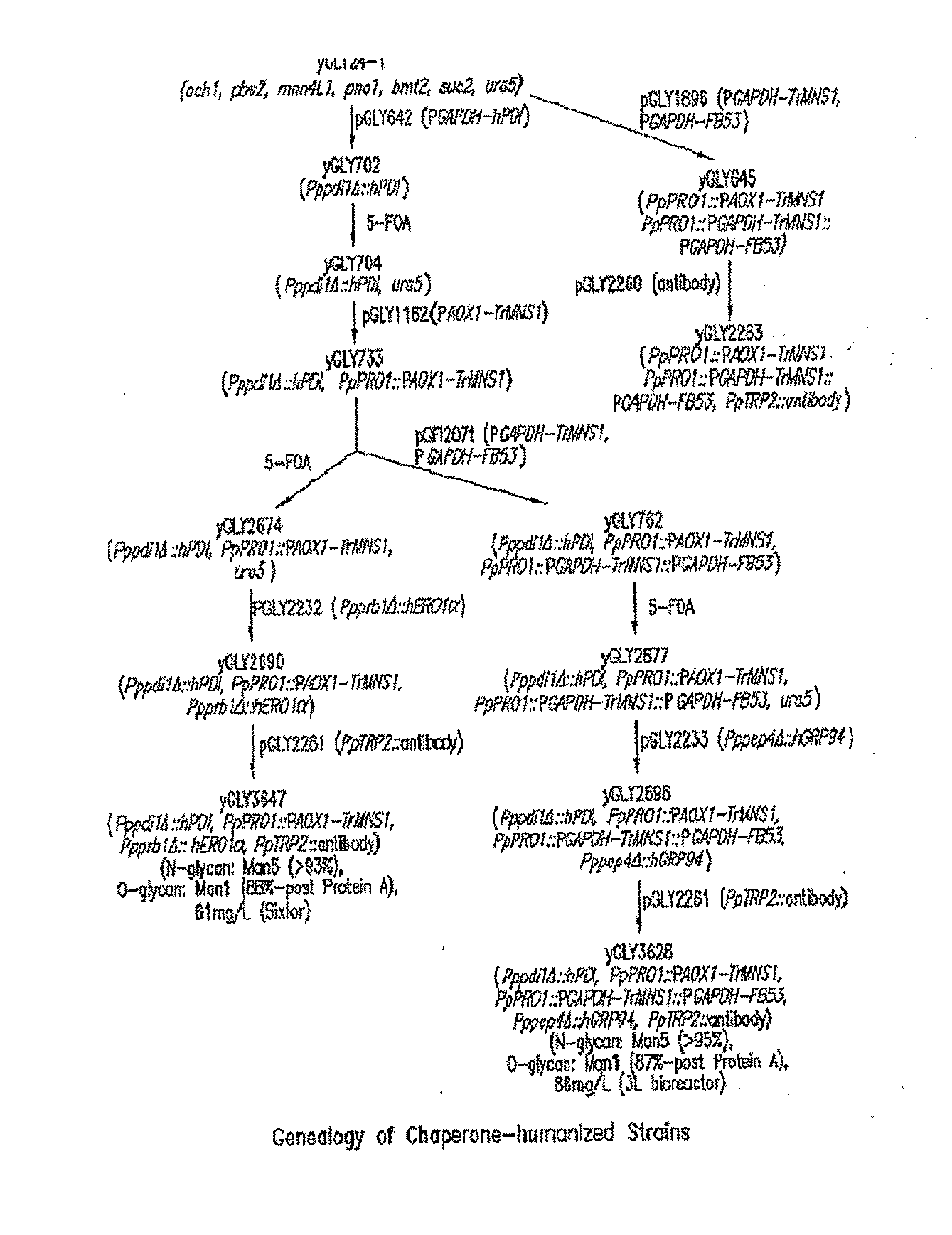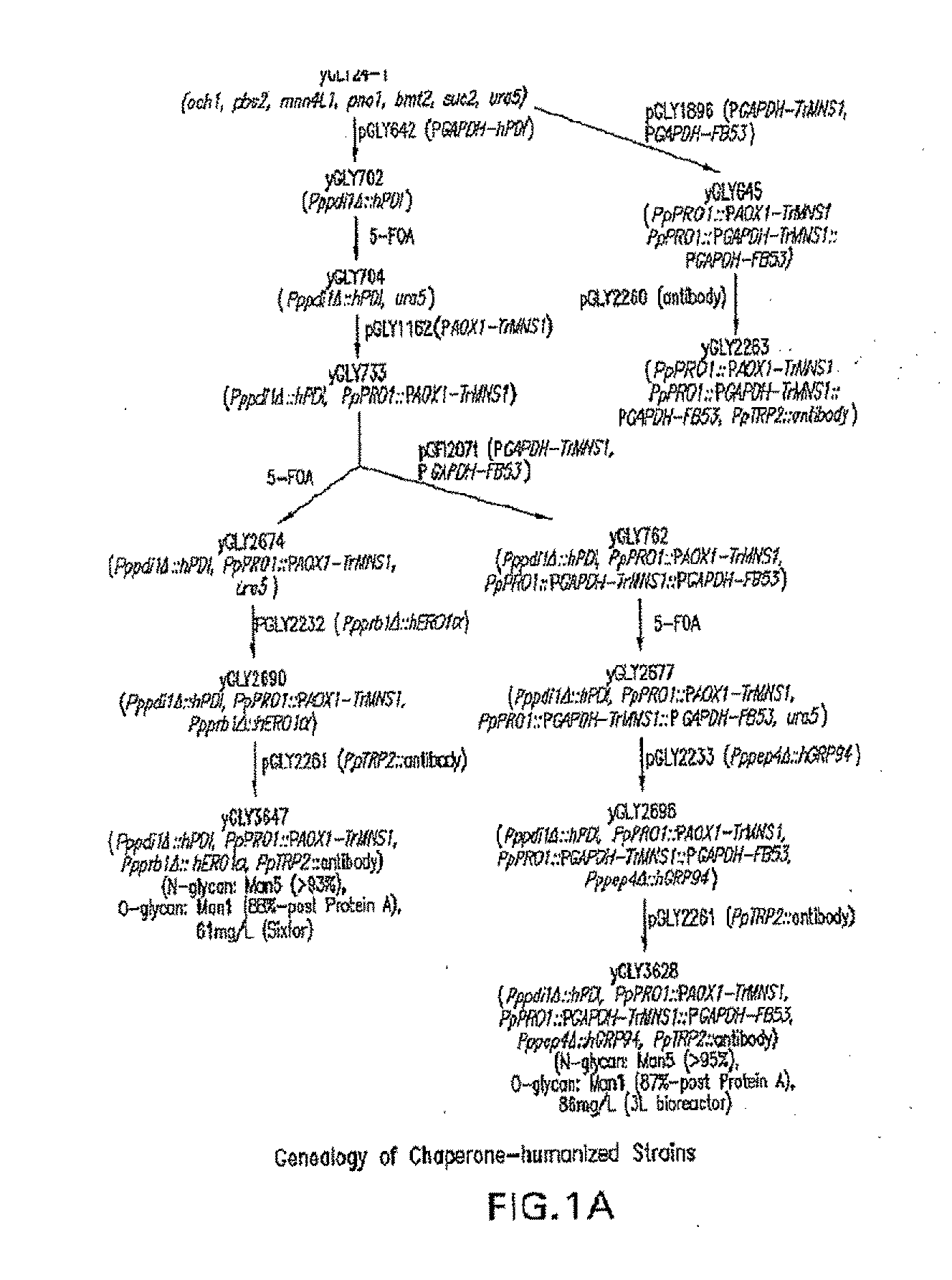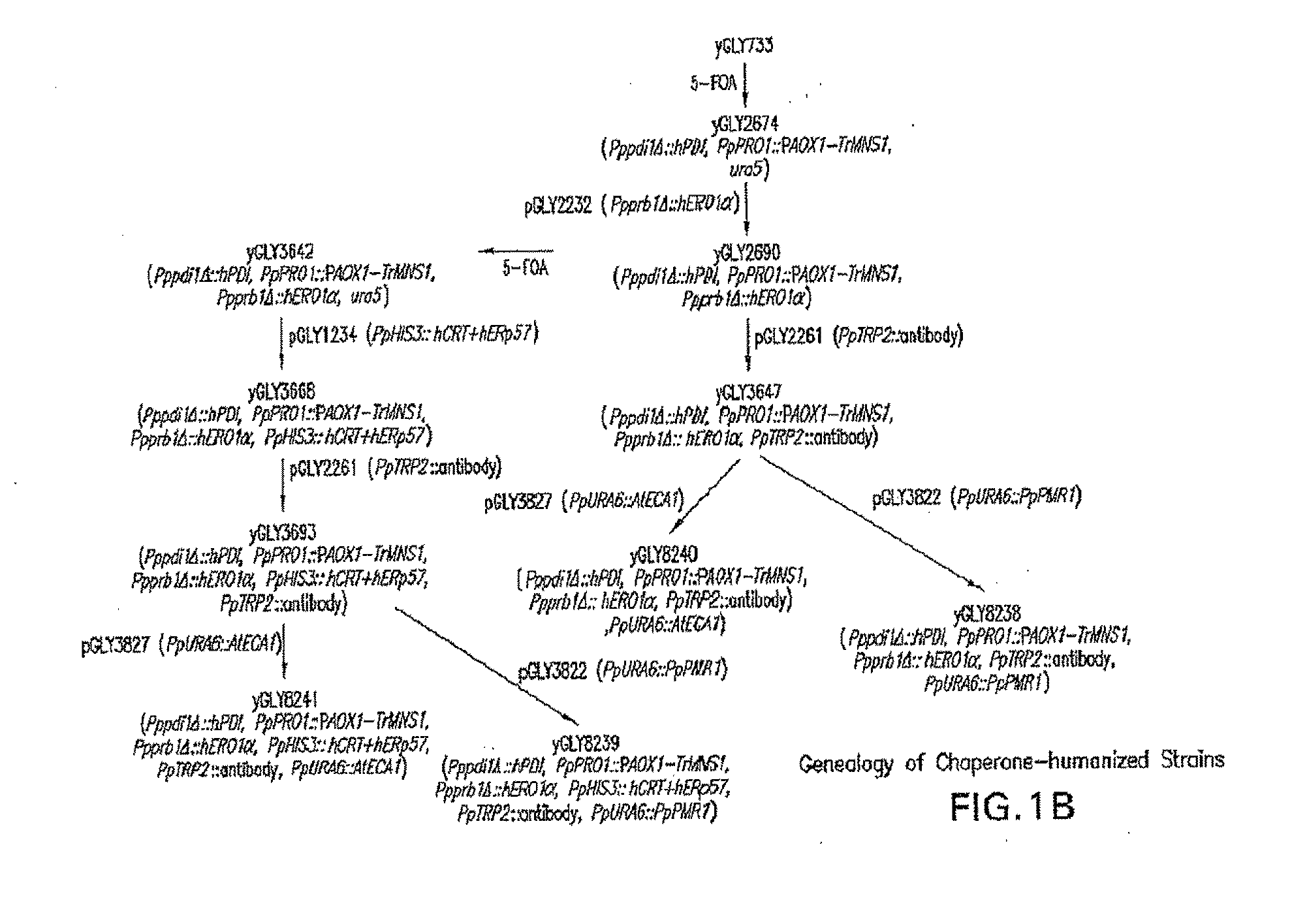Vectors and yeast strains for protein production: ca2+ atpase overexpression
a technology of atpase and vectors, which is applied in the field of host cells, can solve the problems of requiring both ongoing viral containment and significant time to generate stable cell lines, heterogeneous glycoform populations of mammalian cells produced in the process of protein production in mammalian cells, and achieving the effects of enhancing protein stability, enhancing translation efficiency, and stabilizing cytoplasmic mrna
- Summary
- Abstract
- Description
- Claims
- Application Information
AI Technical Summary
Benefits of technology
Problems solved by technology
Method used
Image
Examples
example 1
[0114]This example shows the construction of a recombinant Pichia pastoris that produces recombinant proteins with Man5GlcNAc2 N-glycans.
[0115]Construction of expression / integration plasmid vector pGLY642 comprising an expression cassette encoding the human PDI protein and nucleic acid molecules to target the plasmid vector to the Pichia pastoris PDI1 locus for replacement of the gene encoding the Pichia pastoris PDI1 with a nucleic acid molecule encoding the human PDI was as follows and is shown in FIG. 2. cDNA encoding the human PDI1 was amplified by PCR using the primers hPDI / UP1: 5′ AGCGCTGACGCCCCCGAGGAGGAGGACCAC 3′ (SEQ ID NO: 1) and hPDI / LP-PacI: 5′ CCTTAATTAATTACAGTTCATCATGCACAGCTTTC TGATCAT 3′ (SEQ ID NO: 2), Pfu turbo DNA polymerase (Stratagene, La Jolla, Calif.), and a human liver cDNA (BD Bioscience, San Jose, Calif.). The PCR conditions were 1 cycle of 95° C. for two minutes, 25 cycles of 95° C. for 20 seconds, 58° C. for 30 seconds, and 72° C. for 1.5 minutes, and follo...
example 2
[0144]Cell Growth conditions of the transformed strains for antibody production was generally as follows.
[0145]Protein expression for the transformed yeast strains was carried out at in shake flasks at 24° C. with buffered glycerol-complex medium (BMGY) consisting of 1% yeast extract, 2% peptone, 100 mM potassium phosphate buffer pH 6.0, 1.34% yeast nitrogen base, 4×10−5% biotin, and 1% glycerol. The induction medium for protein expression was buffered methanol-complex medium (BMMY) consisting of 1% methanol instead of glycerol in BMGY. Pmt inhibitor Pmti-3 in methanol was added to the growth medium to a final concentration of 18.3 μM at the time the induction medium was added. Cells were harvested and centrifuged at 2,000 rpm for five minutes.
[0146]SixFors Fermentor Screening Protocol followed the parameters shown in Table 2.
TABLE 2SixFors Fermentor ParametersParameterSet-pointActuated ElementpH6.5 ± 0.130% NH4OHTemperature 24 ± 0.1Cooling Water & Heating BlanketDissolved O2n / aInit...
example 3
[0149]This example demonstrates that occupancy of O-glycans in proteins produced in the above strains expressing the human PDI in place of the Pichia pastoris PDI1 can be significantly reduced when either the Pichia pastoris Golgi Ca2+ ATPase (PpPMR1) or the Arabidopsis thaliana ER Ca2+ ATPase (AtECA1) is overexpressed in the strains. In this example, the effect is illustrated using glycoengineered Pichia pastoris strains that produce antibodies having predominantly Man5GlcNAc2 N-glycans.
[0150]An expression cassette encoding the PpPMR1 gene was constructed as follows. The open reading frame of P. pastoris Golgi Ca2+ ATPase (PpPMR1) was PCR amplified from P. pastoris NRRL11430 genomic DNA using the primers (PpPMR1 / UP: 5′-GAATTCATGACAGCTAATGAAAATCCTTTTGAGAATGAG-3′ (SEQ ID NO:36) and PpPMR1 / LP: 5′-GGCCGGCCTCAAACAGCCATGCTGTATCCATTGTATG-3′ (SEQ ID NO:37). The PCR conditions were one cycle of 95° C. for two minutes; five cycles of 95° C. for 10 seconds, 52° C. for 20 seconds, and 72° C. f...
PUM
| Property | Measurement | Unit |
|---|---|---|
| Fraction | aaaaa | aaaaa |
| Density | aaaaa | aaaaa |
| Density | aaaaa | aaaaa |
Abstract
Description
Claims
Application Information
 Login to View More
Login to View More - R&D
- Intellectual Property
- Life Sciences
- Materials
- Tech Scout
- Unparalleled Data Quality
- Higher Quality Content
- 60% Fewer Hallucinations
Browse by: Latest US Patents, China's latest patents, Technical Efficacy Thesaurus, Application Domain, Technology Topic, Popular Technical Reports.
© 2025 PatSnap. All rights reserved.Legal|Privacy policy|Modern Slavery Act Transparency Statement|Sitemap|About US| Contact US: help@patsnap.com



